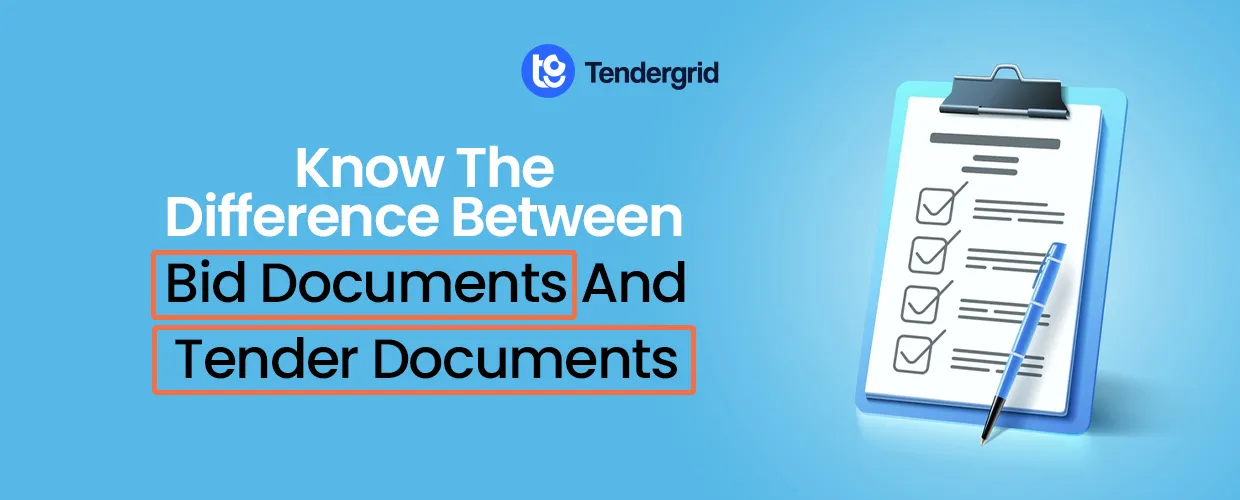
Know The Difference Between Bid Documents And Tender Documents

In the world of contracting, the terms ‘tender’ and ‘bid’ are frequently used, which leads to confusion for those who are not well-versed in the intricacies of procurement process. However understanding of these two crucial factors is important for businesses and individuals who are looking to engage in government contracts and public sector projects. This blog explores the importance of tender grid and provides insights on ISRO Tenders List and Tender Apps.
Understanding Tender Documents
A tender refers to a formal invitation to suppliers to submit a proposal for a specific project, product, or service. This process is used commonly in public sector where transparency and fairness play a crucial role. Tender documents highlight the project requirements, specifications and evaluation criteria. These documents are important for potential bidders as they outline the scope of work and conditions under which they can operate.
Components of Tender Documents
1. Invitation to Tender (ITT)
This tells about the details of projects, eligibility criteria and submission guidelines.
2. Scope of work
This section outlines the tasks, deliverables and outcomes which are expected from tenders.
3. Technical Specifications
This section describes the required standards and methods to be used in the project.
4. Pricing Schedule
It tells about the pricing structure of tenders that includes any variable costs.
Understanding Bid Documents
A bid refers to the proposal submitted by contractors in response to a tender application. It is an acceptance of the tender to undertake specific work at a certain price and under specific conditions.
Components of Bid Documents
1. Bid Form
It refers to standard document that provides information about bidders that includes information such as name of the company and contact information.
2. Pricing Information
This section provides price details, including labor costs and additional expenses.
3. Technical Proporsal
This includes the bidder's approach to completing the project within a specific time period.
4. Supporting Documents
This may include certificates, licenses and financial statements.
5. Executive Summary
This is a brief overview of the bid that highlights the key points and the bidder's understanding of the project.
6. Finanical Proposal
It is the breakdown of costs that are assocated with labour, materials and overhead.
The Bidding Process
Once the tender is published, bidders who are interested accept the proposal. They ensure that their proposal aligns with tender specifications and complies with the evaluation criteria. After submission, bids are opened, allowing stakeholders to review and assess each proposal.
The Tendering Process
The process of tendering starts with the notice of intended procurement, followed by the tender documents. Potential suppliers then prepare and submit their tenders. After that, a rigorous evaluation process takes place, involving a scoring system to ensure objectivity. The tender that offers the best value for money is selected.
Key Difference Between Tenders and Bid Documents
1. Purpose
Tender Documents
Issued for the procurement of goods or services. The main purpose is to invite bids from potential contractors and provide all the necessary details about the bidding process.
Bid Documents
These are responses accepting the tender. They represent the contractor’s proposal to fulfill the requirements outlined in the tender documents.
2. Issuer
Tender Documents
These are issued by the buyer or the owner of the project.
Bid Documents
These documents are prepared and submitted by seller or the contractor.
3. Content Focus
Tender Documents
These are the documents that focus on the scope of work, project requirements, and working conditions.
Bid Documents
These documents focus on contractor’s qualification, pricing, and approach to the project.
4. Format
Tender Documents
Provide clear details of work, which are generally centralized to ensure clarity and consistency.
Bid Documents
Can vary in format and details depending on the style of the contract and the complexity of the project.
Importance of Understanding the Differences
1. Improved Compliance
Understanding the differences helps bidders align proposals with tender requirements, which reduces the risk of disqualification due to non-compliance.
2. Effective Communication
A clear distinction between the two factors facilitates effective communication between contractors and clients.
3. Enhanced Competitiveness
Knowledge of what to include in bid documents can give a competitive edge in bidding.
4. Streamlined Procurement Process
A well understand and smooth process will foster strong communication and interaction between buyer and seller, reducing misunderstanding and delays.
Conclusion
Demystifying bid and tender documents plays a crucial role in the procurement process, whether you are a buyer or a seller. By understanding the differences between these two critical components, businesses can navigate the landscape more effectively, ensuring compliance and building strong communication that improves overall project outcomes. Understanding the Tender Grid, ISRO Tender List, and Tender Apps is crucial for the smooth functioning of business and bridging communication gaps. Mastering tender and bid documents is vital for business growth.
Recent Blogs
Category
- Buildings Tenders
- Agriculture, Livestocks, Forestry & Wildlife Tenders
- Roads & Highways Tenders
- Water & Environment Tenders
- Construction Tenders
- Ministry of Defence Tenders
- Zilla Parishad Tenders
- E-in-c Branch - Military Engineer Services Tenders
- Local Self Government Department (Kerala) Tenders
- Rural Development and Panchayati Raj Tenders
- United Nations Organisations Tenders
- World Bank Tenders
- United Nations Development Programme Tenders
- New Zealand Government Electronic Tenders Service Tenders
- German Society for International Cooperation Tenders